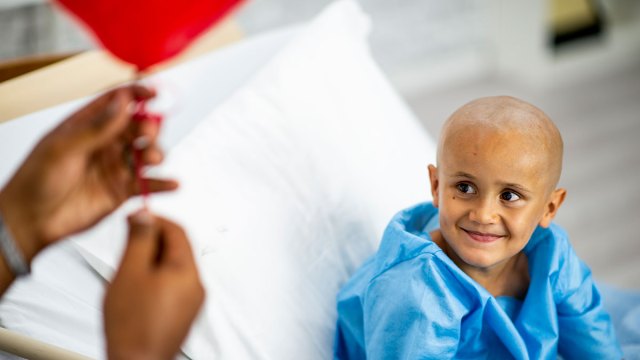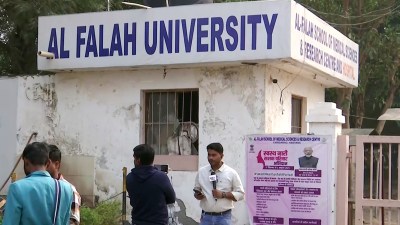Improving Survival Rates of Pediatric Cancers in Developing Countries
Principles of Management of these childhood cancers are same across the countries, but chemotherapy protocol varies slightly as per the research done locally and as per the local requirement.
 Improving Childhood Cancer Survival
Improving Childhood Cancer Survival When previously healthy, active 3 years old Sadana (name changed) got diagnosed as acute lymphoblastic leukemia (ALL), the family got completely shattered, listening to the problem. Because of common belief in the public on cancer, they couldn’t believe initially that it does carry more than 80 to 85 % chances of cure. She came with a history of fever, along with pain in joints and legs. Her initial investigations and treatment options did not reveal definite diagnosis and symptomatic treatment. Later he started dropping blood counts, got diagnosed as ALL and treated for the same. Currently she is more than 3 years off treatment and leading a normal life.
Overall, the cancer is increasing in incidence across the world so in India as well. Pediatric Cancer accounts for 7 to 10% of all cancers occurring every year.
Ten years ago, around 40,000 new cancers are diagnosed in children every year but now more than 55, 000 new cases are getting diagnosed and adding on to the existing pool. In the last two decades the incidence of cancer doubled, partly because of true incidence going up and partly secondary to better awareness of the problem in the general public and early diagnosis as people are reaching out to centers where diagnosis and treatment is available.
Thankfully many of the childhood cancers are highly treatable provided they are diagnosed on time and treated in appropriate centers where facilities and expertise to manage these children are available. This includes pediatric oncologist, pediatric surgeons, critical care team, other subspecialities like pediatric neurology, trained and competent nursing staff, dieticians, psychologists etc. In the last 3 decades, a common pediatric cancer like acute lymphoblastic leukemia survival rate improved from 20% to more than 80%.
In children, cancers are more common in boys compared to girls. Most common childhood malignancy is acute leukemia also called commonly as blood cancer (30 to 35 % of total childhood cancers) followed by brain tumors, euroblastoma, lymphoma (lymph nodes), wilms tumor (kidney), muscle and soft tissue and others.
Cancer symptoms depend on type, site and stage of cancer. Common symptoms of most common cancer, i.e acute leukemia include unexplained fever, pallor, bleeding, bone/joint pains. Symptoms of solid tumors mainly dependent on the site like brain tumors present with headache, vomiting, seizures, altered sensorium etc. Whereas tumors arising in the abdomen, generally present with abdominal distention, pain and other symptoms. Initial evaluation with complete blood counts, blood smear examination will raise the suspicion of acute leukemia, which should further get confirmed with bone marrow examination. Also doing genetic tests on this sample will help in risk stratification of these cases. Other cancers like solid tumors require local imaging followed by confirmation with biopsy, histopathology examination. Further staging of solid tumors is done with scans like PET scan, Bone Marrow examination etc.
Principles of Management of these childhood cancers are same across the countries, but chemotherapy protocol varies slightly as per the research done locally and as per the local requirement. Management is divided into specific treatment which includes chemotherapy, surgery and radiotherapy where it is indicated and supportive care. In addition to chemotherapy, supportive care that is provided during management is very important. This includes safe use of blood products, timely and effective management of infections with antibiotics and antifungals. Preventive measures – for infection prevention, good nutritional support, safe blood products, appropriate antibiotics and antifungal usage – play a key role in supportive care. Other measures like pain control, psychological support and actively engaging families in care of their children are very important. Even in developing countries like ours with combined multimodal treatment in an appropriate center, where children are handled carefully, one can achieve results at par with western countries and many children are becoming long term survivors leading normal life.
 Dr. Sirisha Rani, Pediatric Hematologist & Oncologist, MD (Peds), DNB, MRCPCH (UK), Fellow Ped. Hemato-Oncology and BMT (UK), Rainbow Children’s Hospital, Banjara Hills
Dr. Sirisha Rani, Pediatric Hematologist & Oncologist, MD (Peds), DNB, MRCPCH (UK), Fellow Ped. Hemato-Oncology and BMT (UK), Rainbow Children’s Hospital, Banjara Hills
Pediatric Hematologist & Oncologist
MD (Peds), DNB, MRCPCH (UK), Fellow Ped. Hemato-Oncology and BMT (UK)



- 01
- 02
- 03
- 04
- 05



























